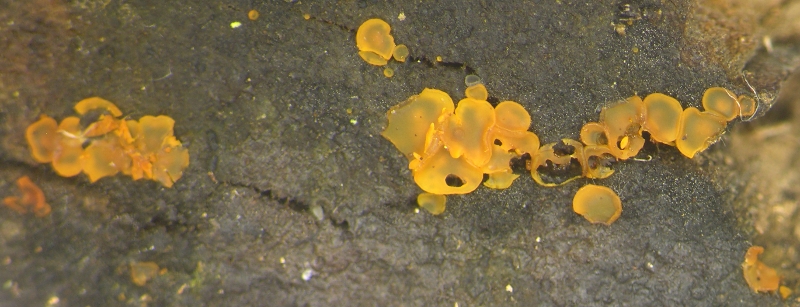Home >> Diversity and classification >> True fungi >> Dikarya >> Ascomycota >> Discomycetes >> Nematophagous Discomycetes
ORBILIOMYCETES: THE NEMATOPHAGOUS DISCOMYCETES

This group of discomycetes is rather difficult to define but usually not difficult to recognize. The photo above of Orbilia xanthostigma, showing minute, brightly-coloured, rather transluscent apothecia is quite typcal of the whole class. Long considered to be members of the Leotiomycetes, recent molecular studies have shown them to be genetically distinct. A very detailed discussion of the Orbiliomycetes by Baral, Eriksson, Marson and Weber can be read online at Myconet under Notes 3591 and 3592. In addition Dr. Baral has an excellent web page with photographs of Orbiliomycetes.

The Class Orbiliomycetes is a relatively small group, containing a single order, the Orbiliales and a single family, the Orbiliaceae. Species of Orbilia, the largest genus in the Orbiliaceae, are generally easy to recognize in the field, provided you have a good hand-lens. Under the microscope many species are seen to have knob-tipped paraphyses and asci with prominant hyphal connections. The ascospore are often minute and take a great variety of shapes. Orbilia xanthostigma has rather bean-shaped ascospores but the example in the photos was too young to show these very well. In addition to Orbilia with its approximately 210 species, the Orbiliomycetes includes Hyalorbilia with about 20 species and three as yet undescribed genera with one species each.
Asexual reproduction in the Orbiliomycetes is highly developed, suggesting that this is an important part their life histories. Before these states were known to be part of the life cycle of the Orbiliomycetes they were assigned to several anamorphic genera, well-known to most mycologists and outlined on the page discussing the anamorphs of Orbiliaceae.
Perhaps the most interesting feature of the Orbiliomycetes is the life history of its species. Nearly all appear to possess the ability to capture and consume nematode worms (roundworms). Nematodes are among the most abundant animals on earth, occurring in a huge range of habitats. These snake-like worms crawl among fungal hyphae, consuming bacteria, yeasts and sometimes the fungi themselves. Being abundant and rich in protein it is not surprising that some fungi have turned to nematodes as a source of nutrition. Species of the Orbiliaceae use a variety of traps to capture their prey, outlines in the pages on animal parasites and anamorphs of Orbiliaceae.